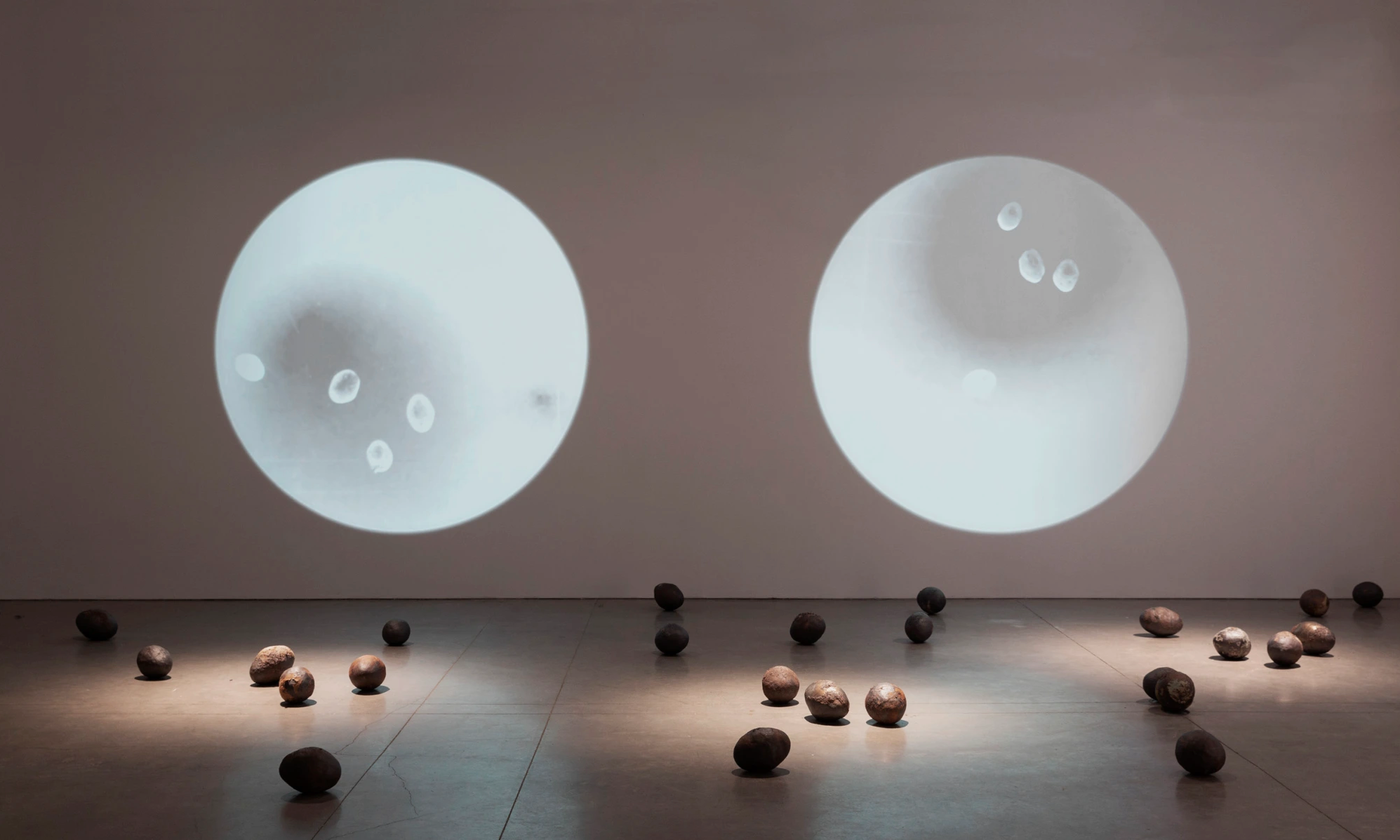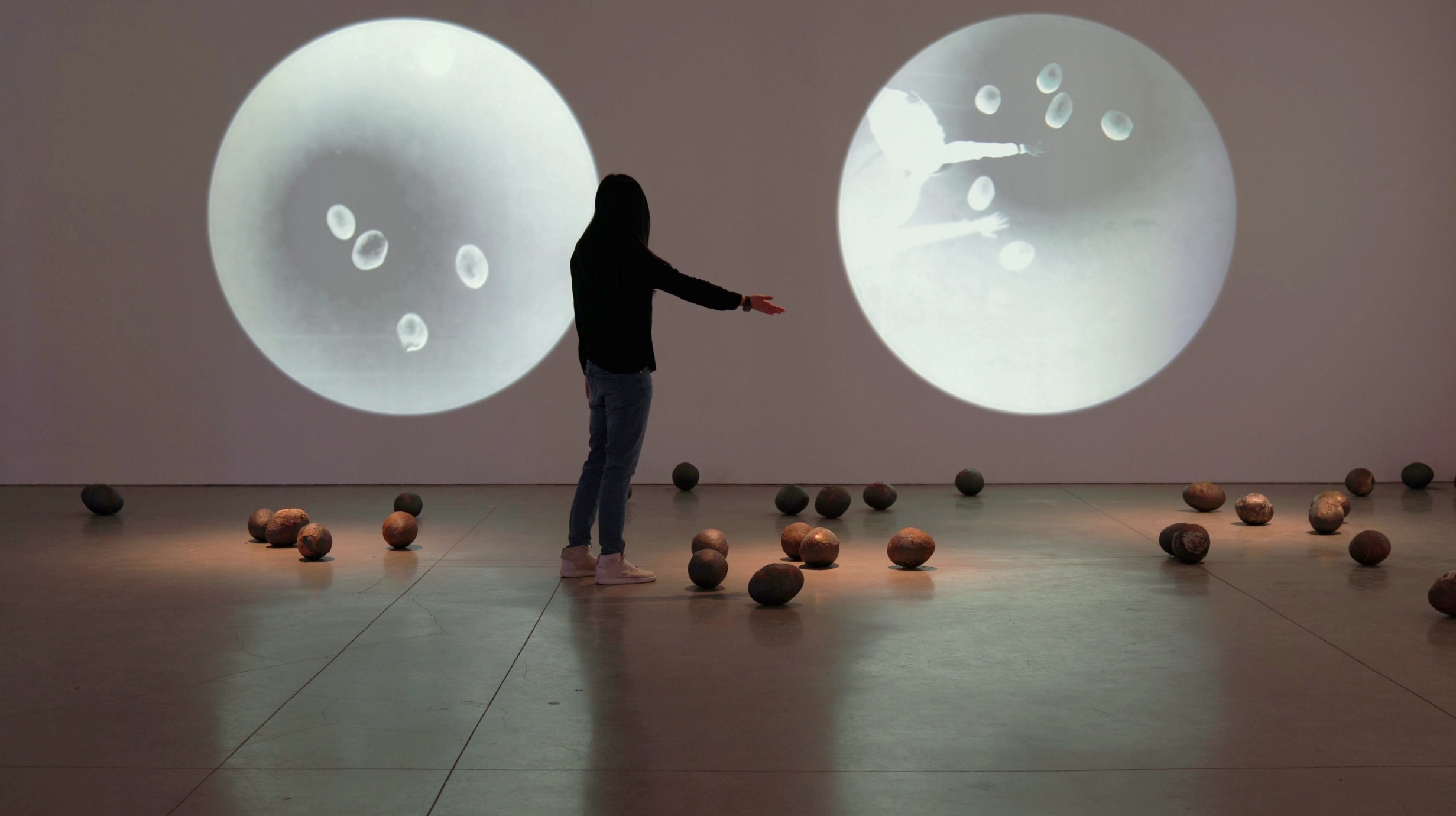
VACUOLES: BIOREMEDIATING CULTURES
— 2019
INSTALLATION: 29 CERAMIC PIECES CONTAINING LEAD-CONTAMINATED SOIL FROM SOUTH EAST LA, THREE-CHANNEL VIDEO PROJECTIONS.
Lead-contaminated soil from South East LA, mustard plants, fishbone, glass container, microscope, webcams, and live feed projections.
Database of the 29 most lead-contaminated parks, schools, or child care centers in Los Angeles (selection from public domain database of 10,000 contaminated properties from Exide case updated March 2019), Lead case article, Lead-blood test results, Poem.
This project resulted from research into an environmental and social crisis specific to South East LA, where thousands of families face severe lead contamination in land affected by a company recycling car batteries. As part of the research, soil samples were collected and encapsulated in oval shape ceramic pieces. This artwork responded to some plants’ bioremediating action in their vacuoles, where they absorb the lead and encapsulate it in these cellular organelles. The work is presented as an interactive installation, and the “vacuoles” represent the 29 most contaminated parks, schools, or childcare centers in South East LA.
The viewers can walk around these vacuoles and think about themselves as “bioremediating organisms.” Their image is projected on the wall as they move around the space, resembling a Petri dish or a microscopic view. This is an invitation to exercise our possibility to act as remediators instead of exploiters.
RESEARCH
Vacuoles is a project that results from the research done on the Exide case that occurred recently in South East Los Angeles. This problem is an example of complexity and causality, where the interactions of the participants show how our culture of unsustainability based on individualism, consumerism, and infinite resources idea is affecting ecosystems, starting with the most vulnerable.
There are several artists that have tried to produce work that not only talks about environmental implications, but that actually helps to solve the problem. In my case, I wanted to research ways to remediate this specific contaminated area. Through Bioremediation, plants and microorganisms are able to reduce the availability of contaminants in the air and soil. Specifically for lead, there are two studied plants that help stabilize lead, avoiding it to keep floating or being introduced into the food chain. This is the case with the mustard plant [1] and the sunflower.
I found it interesting how these plants are able to work in symbiosis with other organisms in the soil, absorbing and keeping the contaminant in their roots. The way they are able to deal with it is by storing the lead in some cellular organelles called “vacuoles”. For me, this act of encapsulation was very interesting and made me want to respond to it.
For that purpose, I went to Exide and parks that are around the contaminated area to take samples of the soil. And thinking about the idea that we shouldn’t be extracting lead, and that it is needed to bring it back to the ground, I decided to mimic the activity of the plants and encapsulate myself the contaminated soil in ceramic pieces that I called ‘vacuoles’.
This can be thought of just as a gesture, but I want to call this an act of remediation through an unconventional method. I’m putting back and isolating.[2] The soil is being removed, and the contaminant is no longer exposed to the environment. It is a very inefficient method but probably is comparable to what the government is doing in taking the soil and dumping everything into the landfill.
The decision of using ceramics and specifically clay as the medium for this remediation was related to the idea of bringing the contaminant to the ground. Ceramics has its own history of the use of lead, and it was interesting to note that while I was attempting to encapsulate lead, this was also available in glazes in the lab. I decided to not use any glazing available in the lab that could have lead, for obvious reasons.
[1] The mustard plant is also considered an invasive species, and it has a cultural reference as a representation of colonization by the Spaniards. It’s interesting to see how this simple plant has these different connotations as a weed, invasive, colonizer, but at the same time, remediator, resilient.
[2] Actually, this is another method by which remediation can be done: by covering the area with rocks and cement. This is not recommended because diminishes biodiversity and unfortunately is the basis on which a landfill is conceived and other toxic wastelands are built.




EXIDE CASE:
LEAD CONTAMINATION IN LA
In 2015 a lead-acid recycling plant located in Vernon, California, and the property of Exide Industries was forced to close due to massive soil contamination in southeast LA, affecting more than 10,000 properties.[1] Regulators say lead emissions from the Exide plant drifted across an area of residential properties spanning seven communities: Bell, Boyle Heights, Commerce, East Los Angeles, Huntington Park, Maywood, and Vernon. The state soil sampling results show that more than 98% presented lead levels exceeding 80 parts per million, California’s health standard for residential soil.
The government forced Exide to pay for the repair of damages, but the cleaning costs surpassed the amount charged, and the process is slow. This is a clear example of environmental injustice, where the most vulnerable communities face a severe ecological burden. Investigations show that this plant had violated environmental regulations for more than 30 years as state regulators turned a blind eye. The government has started a prolonged cleaning process, which consists of taking the soil from each property and depositing it in the landfill while replacing it with new soil.
Lead is a heavy metal known for its high density. Humans have used it since ancient times. Its characteristic gray color and soft appearance were known by the Romans, who used it for plumbing installations (the reason for its chemical symbol Pb – plumbum). [2]
The US Environmental Protection Agency (EPA) reports that more than 40 million tons of toxic waste are produced yearly in the United States. Of the hazardous wastes found on the ATSDR list, lead is number 2.[3] Lead dispersion through the environment comes primarily from anthropogenic soil, ground, and air activities. It has been used in paints (for 50 years), bullets, fuel additives (for 70 years), and the lead-acid battery industry (car batteries).
Lead used in paints and as a fuel additive was banned when the US Environmental Protection Agency found it dangerous for its exposure to humans, particularly children, since it acts as a neurotoxin, affecting the nervous system. Children are more susceptible to its effects because they can absorb four times more than adults. “Its poisoning causes problems in children such as impaired development, reduced intelligence, loss of short-term memory, learning disabilities and coordination problems; causes renal failure; increased risk for development of cardiovascular disease.”[4] In California, the limit for lead in soil is 80 ppm. [5]
The increased use of cars promoted by the oil and car industries has directly impacted the need for the extraction and recycling of lead for the production of lead batteries. This means that human transportation is causing lead to be moved in this unsustainable system. Animals also are affected by lead. A recent study discovered that lead exposure may be shared among wildlife living in urban areas and is associated with increased aggression, particularly in birds. [6] The same behavioral changes are seen in humans, existing a correlation between lead exposure and violence in contaminated cities. [7]
Important advocacy work is being led by community members and organizations, asking the government to hold Exide accountable, demanding justice and the complete remediation of the area.
A personal source of concern is that these problems in recycling plants in the US are increasingly sending used batteries to Mexico for recycling. Avoiding the damage on the US territory by affecting other regions is another example of environmental injustice. This goes in hand with the consumerist system that disconnects sources, products, and final disposition of residues with the idea of “out of sight, out of mind.” [8]
SOURCES
[1] Tony Barboza, “What We Know about California’s Largest Toxic Cleanup : Thousands of L . A . County Homes Tainted with Lead,” Los Angeles Times, August 6, 2017.
[2] Actually, there exists a theory that the Roman Empire could possible collapsed because of the high levels of lead in the population.
[3] Zhaoyu Kong and Bernard Glick, “The Role of Plant Growth-Promoting Bacteria in Metal Phytoremediation,” Advances in Microbial Physiology 71 (2017): 97–132.
[4] Hazrat Ali, Ezzat Khan, and Muhammad Anwar, “Chemosphere Phytoremediation of Heavy Metals — Concepts and Applications” 91 (2013): 869–81.
[5] “Exide Home. California Department of Toxic Substances Control.,” n.d., http://www.dtsc.ca.gov/HazardousWaste/Projects/UpdateExideSuspension.cfm .
[6] Stephanie McClelland, “Sub-Lethal Exposure to Lead Is Associated with Heightened Aggression in an Urban Songbird,” Science of The Total Environment 654 (2019): 593–603.
[7] Rick Nevin, “Understanding International Crime Trends: The Legacy of Preschool Lead Exposure,” Environmental Research 104 (2007): 315–36, https://doi.org/10.1016/j.envres.2007.02.008.
[8] Elisabeth Rosenthal, “Recycled Battery Lead Puts Mexicans in Danger – The New York Times,” New York Times, December 8, 2011, http://www.nytimes.com/2011/12/09/science/earth/recycled-battery-lead-puts-mexicans-in-danger.html?searchResultPosition=1.









